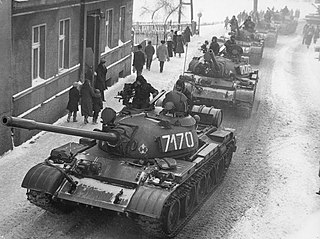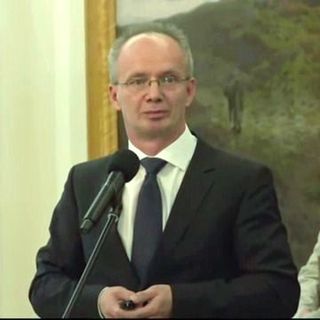Related Research Articles

Henryk Józef Muszyński is the Primate Emeritus of Poland and former archbishop of Gniezno, Poland, having been appointed by Pope John Paul II when the Polish hierarchy was reorganized in March 1992. He had previously been Bishop of Włocławek since 1987.

The bombing of Wieluń is considered by many to be the first major act of World War II, and the September Campaign. After Luftwaffe air units moved into Polish airspace in the early morning of 1 September, they reached the town of Wieluń by 04:40–45 hours. Around this time, the first strikes on the town were conducted, with a total of 46,000 kg bombs being dropped on civilian targets for 9 consecutive hours. Elsewhere, the Battle of Westerplatte and Danzig skirmishes began around the same time, starting the well-coordinated Invasion of Poland.

Armia Ludowa was a communist partisan force set up by the communist Polish Workers' Party (PPR) during World War II. It was created on the order of the Polish State National Council on 1 January 1944. Its aims were to fight against Nazi Germany in occupied Poland, support the Soviet Red Army against the German forces and aid in the creation of a pro-Soviet communist government in Poland.

Martial law in Poland refers to the period between the 13th December 1981 and the 22nd July 1983, when the government of the Polish People's Republic drastically restricted everyday life by introducing martial law and a military junta in an attempt to counter political opposition, in particular the Solidarity Movement. Thousands of opposition activists were imprisoned without charge, and as many as 91 killed. Although martial law was lifted in 1983, many political prisoners were not released until a general amnesty in 1986.

Operation Vistula was a codename for the 1947 forced resettlement of the Ukrainian minority including Boykos and Lemkos from the south-eastern provinces of post-war Poland, to the Recovered Territories in the west of the country. The action was carried out by the Soviet-installed Polish communist authorities with the aim of removing material support and assistance to the Ukrainian Insurgent Army. The Ukrainian Insurgent Army continued its guerilla activities until 1947 in both Subcarpathian and Lublin Voivodeships with no hope for any peaceful resolution. Operation Vistula effectively brought an end to the hostilities.
Movement for Defence of Human and Civic Rights was a right-wing political and social organization formed in People's Republic of Poland in March 1977. It tried to resist the regime by denouncing it for violating Polish and international laws including the Constitution of the People's Republic of Poland and International Covenant on Civil and Political Rights.
Robotnik was the name of an underground newspaper (bibuła) published by the democratic socialist wing of the Solidarity resistance movement in the People's Republic of Poland during the period of martial law in Poland, between the years 1983 and 1990. It was named after the Polish Socialist Party pre-war periodical of the same name.

Szmalcownik ; in English, also sometimes spelled shmaltsovnik) is a pejorative Polish slang expression that originated during the Holocaust in Poland in World War II and refers to a person who blackmailed Jews who were in hiding, or who blackmailed Poles who aided Jews during the German occupation. By stripping Jews of their financial resources, blackmailers added substantially to the danger that Jews and their rescuers faced and increased their chances of getting caught and killed.

The Ciepielów massacre that took place on 8 September 1939 was one of the largest and best documented war crimes of the Wehrmacht during its invasion of Poland. On that day, the forest near Ciepielów was the site of a mass murder of Polish prisoners of war from the Polish Upper Silesian 74th Infantry Regiment. The massacre was carried out by soldiers from the German Wehrmacht 15th Motorized Infantry Regiment, 29th Motorized Infantry Division, under the command of Colonel Walter Wessel.

Rafał Wnuk is a Polish historian, editor of several historical periodicals, employee of the Institute of History of the Polish Academy of Sciences and of the Polish Institute of National Remembrance (IPN). Wnuk was a student of the Polish historian Tomasz Strzembosz.

The Intelligenzaktion Pommern was a Nazi German operation aimed at the eradication of the Polish intelligentsia in Pomeranian Voivodeship and the surrounding areas at the beginning of World War II. It was part of a larger genocidal Intelligenzaktion, that took place across most of Nazi-occupied western Poland in the course of Operation Tannenberg, purposed to install Nazi officials from Sipo, Kripo, Gestapo and SD at the helm of a new administrative machine.

The Expulsion of Poles by Nazi Germany during World War II was a massive Nazi German operation consisting of the forced resettlement of over 1.7 million Poles from all territories of occupied Poland with the aim of their geopolitical Germanization between 1939 and 1944. The expulsions were justified by Nazi racial doctrine, which depicted Poles and other Slavs as racially inferior Untermenschen.

Krzysztof Szwagrzyk is a Polish historian, publicist and writer, since 1979 living and working in Wrocław, Poland. Szwagrzyk received his doctoral degree in 20th-century history from the University of Wrocław in 1996. He serves as president of the Public Information Bureau of the Institute of National Remembrance regional chapter in Wrocław, and is the author of numerous scientific papers and several monographs about contemporary Polish history, with special focus on the system of political repressions during the period of Stalinism in Poland, and the anti-communist structures in Lower Silesia in the years of 1945–1956. He's the author of screenplay Golgota Wrocławska.

Siedlce pogrom refers to the events of September 8–10 or 11, 1906, in Siedlce, (Congress) Kingdom of Poland. It was part of a wave of pogroms in Russia and controlled territories, in the larger context of the widespread unrest. The pogrom in Siedlce was organized by the Russian secret police (Okhrana). There were 26 fatalities among the Jewish populations.

Dariusz Stola is a professor of history at the Institute of Political Studies of the Polish Academy of Sciences.
Main City is the central, historic part of Gdańsk's borough of Śródmieście. Unlike the Old Town and the New Town, the area was rebuilt after World War II and includes some of the city's best known historical monuments, including the St. Mary's basilica, Golden Gate, Artus Court, Main City Hall, the Royal Road, Long Lane and Long Market.
Stanisław Ostwind-Zuzga – Master Sergeant of Polish Army, major of National Armed Forces (NSZ), local commandant of NSZ in Węgrów, one of the highest ranked officers of Jewish background in Polish anti-Nazi resistance during World War II.
Throughout World War II, Poland was a member of the Allied coalition that fought Nazi Germany. During the German occupation of Poland, some citizens of all its major ethnic groups collaborated with the Germans. Estimates of the number of collaborators vary. Collaboration in Poland was less institutionalized than in some other countries and has been described as marginal. During and after the war, the Polish government in exile and the Polish resistance movement punished collaborators and sentenced to death thousands of them.
Chief Commission for the Prosecution of Crimes against the Polish Nation is a governmental agency created in 1945 in Poland. It is tasked with investigating German atrocities and communist ones. In 1999 it was transformed into the main organizational unit of the investigative department of the Institute of National Remembrance.

The Żegota Monument is a stone monument dedicated to the Żegota organization, which rescued Jews during the Holocaust in Poland. It is on Anielewicza Street in Warsaw in the Muranów neighborhood of Warsaw, Poland, near the Monument to the Ghetto Heroes and the POLIN Museum of the History of Polish Jews.
References
- 1 2 3 Ray Taras (1984). Ideology in a Socialist State: Poland 1956-1983. Cambridge University Press. p. 145. ISBN 978-0-521-26271-2.
- 1 2 Józef Majka (1982). Filozofia społeczna. Ośrodek Dokumentacji i Studiów Społecznych. p. 198.
- ↑ Ray Taras (1984). Ideology in a Socialist State: Poland 1956–1983. Cambridge University Press. p. 222. ISBN 978-0-521-26271-2.
- ↑ Jane Leftwich Curry (1990). Poland's Journalists: Professionalism and Politics. Cambridge University Press. p. 66. ISBN 978-0-521-36201-6.
- ↑ Grzegorz Musiał (1998). Poems of Grzegorz Musial: Berliner Tagebuch and Taste of Ash. Fairleigh Dickinson Univ Press. p. 25. ISBN 978-0-8386-3783-8.
- ↑ Śląski kwartalnik historyczny Sobótka. Zakład Narodowy im. Ossolińskich. 2005. p. 424. Retrieved 10 September 2013.
- 1 2 Anikó Imre; Timothy Havens; Kati Lustyik (2012). Popular Television in Eastern Europe During and Since Socialism. Routledge. p. 75. ISBN 978-0-415-89248-3.
- ↑ Konrad Rokicki; Sławomir Stępień; Instytut Pamięci Narodowej--Komisja Ścigania Zbrodni przeciwko Narodowi Polskiemu (2009). W objęciach Wielkiego Brata: Sowieci w Polsce, 1944-1993. Instytut Pamięci Narodowej. p. 86. ISBN 978-83-7629-060-7.
- ↑ Jakub Basista (2000). Dzieje Polski: kalendarium. Wydawn. Literackie. p. 787. ISBN 978-83-08-03028-8.
- ↑ Jane Leftwich Curry (1990). Poland's Journalists: Professionalism and Politics. Cambridge University Press. p. 67. ISBN 978-0-521-36201-6.
- ↑ Ryszard Chruściak (2007). Krajowa Rada Radiofonii i Telewizji w systemie politycznym i konstytucyjnym. Dom Wydawniczy "Elipsa". p. 27. ISBN 978-83-7151-792-1.
- ↑ Brian McNair (2012). Glasnost, Perestroika and the Soviet Media. Routledge. p. 364. ISBN 978-1-134-96022-4.